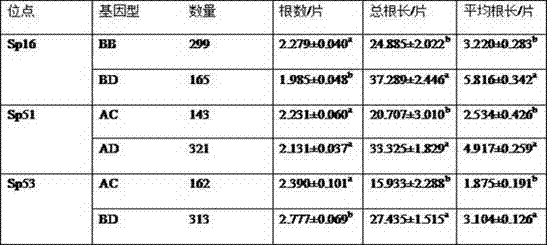Method for screening molecular markers related to spirodela oligorrhiza root growth
A molecular marker, root growth technology, applied in biochemical equipment and methods, microbial determination/inspection, etc., to achieve the effect of improving biological treatment efficiency and fast detection speed
- Summary
- Abstract
- Description
- Claims
- Application Information
AI Technical Summary
Problems solved by technology
Method used
Image
Examples
Embodiment 1
[0015] The method for screening the molecular markers related to the growth of Pygnus chinensis includes clone culture, genomic DNA extraction, design of microsatellite primers, PCR amplification, and data statistics and analysis.
[0016] The composition and concentration of the nutrient solution for plant clone culture are: nitrogen 0.3~0.4g / L, phosphoric anhydride 0.1~0.15 g / L, potassium oxide 0.16~0.23 g / L, magnesium oxide 0.01~0.015 g / L and sulfur 0.012 ~0.02 g / L. The above-mentioned nutrient solution can comprehensively provide the macroelements and trace elements required for the growth of P. chinensis, the asexual reproduction speed is fast, the probability of gene mutation is low, and a large number of plants with the same gene can be obtained, and the sample size is sufficient.
[0017] The plant clones were cultured indoors in a light incubator for 50-70 days, the culture conditions were 22.5-23.5°C, the humidity was 73-83%, the light intensity was 1800-2200lux, and...
Embodiment 2
[0022] The method for screening the molecular markers related to the growth of Pygnus chinensis includes clone culture, genomic DNA extraction, design of microsatellite primers, PCR amplification, and data statistics and analysis.
[0023] The composition and concentration of the nutrient solution for plant clone cultivation are: nitrogen 0.32 g / L, phosphoric anhydride 0.12 g / L, potassium oxide 0.19 g / L, magnesium oxide 0.012 g / L and sulfur 0.016 g / L. The above-mentioned nutrient solution can comprehensively provide the macroelements and trace elements required for the growth of P. chinensis, the asexual reproduction speed is fast, the probability of gene mutation is low, and a large number of plants with the same gene can be obtained, and the sample size is sufficient.
[0024] The plant clones were cultivated indoors for 60 days in a light incubator, the culture conditions were 23°C, humidity 78%, light intensity 2000lux, and light-dark time 16:8h. Under the above-mentioned ...
Embodiment 3
[0029] The method for screening the molecular markers related to the growth of Pygnus chinensis includes clone culture, genomic DNA extraction, design of microsatellite primers, PCR amplification, and data statistics and analysis.
[0030] The composition and concentration of the nutrient solution for plant clone cultivation are: nitrogen 0.32g / L, phosphoric anhydride 0.12g / L, potassium oxide 0.2g / L, magnesium oxide 0.013g / L and sulfur 0.017g / L. The above-mentioned nutrient solution can comprehensively provide the macroelements and trace elements required for the growth of P. chinensis, the asexual reproduction speed is fast, the probability of gene mutation is low, and a large number of plants with the same gene can be obtained, and the sample size is sufficient.
[0031] The number of roots / piece, total root length / piece and average root length / piece were counted for each plant (leaves connected) in different culture lines.
[0032] Microsatellite primers are: Sp16; F: GGATC...
PUM
 Login to View More
Login to View More Abstract
Description
Claims
Application Information
 Login to View More
Login to View More - Generate Ideas
- Intellectual Property
- Life Sciences
- Materials
- Tech Scout
- Unparalleled Data Quality
- Higher Quality Content
- 60% Fewer Hallucinations
Browse by: Latest US Patents, China's latest patents, Technical Efficacy Thesaurus, Application Domain, Technology Topic, Popular Technical Reports.
© 2025 PatSnap. All rights reserved.Legal|Privacy policy|Modern Slavery Act Transparency Statement|Sitemap|About US| Contact US: help@patsnap.com


